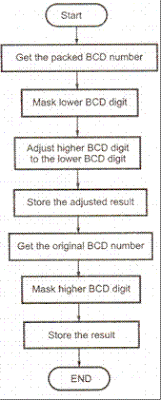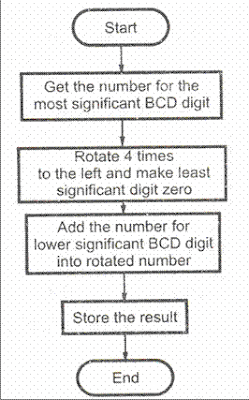Memory
Program, data and stack memories occupy the same memory space. The total addressable memory size is 64 KB.
Program memory - program can be located anywhere in memory. Jump, branch and call instructions use 16-bit addresses, i.e. they can be used to jump/branch anywhere within 64 KB. All jump/branch instructions use absolute addressing.
Data memory - the processor always uses 16-bit addresses so that data can be placed anywhere.
Stack memory is limited only by the size of memory. Stack grows downward.
Interrupts
The processor has 5 interrupts. They are presented below in the order of their priority (from lowest to highest):
INTR is maskable 8080A compatible interrupt. When the interrupt occurs the processor fetches from the bus one instruction, usually one of these instructions:
- One of the 8 RST instructions (RST0 - RST7). The processor saves current program counter into stack and branches to memory location N * 8 (where N is a 3-bit number from 0 to 7 supplied with the RST instruction).
- CALL instruction (3 byte instruction). The processor calls the subroutine, address of which is specified in the second and third bytes of the instruction.
RST5.5 is a maskable interrupt. When this interrupt is received the processor saves the contents of the PC register into stack and branches to 2Ch (hexadecimal) address.
RST6.5 is a maskable interrupt. When this interrupt is received the processor saves the contents of the PC register into stack and branches to 34h (hexadecimal) address.
RST7.5 is a maskable interrupt. When this interrupt is received the processor saves the contents of the PC register into stack and branches to 3Ch (hexadecimal) address.
Trap is a non-maskable interrupt. When this interrupt is received the processor saves the contents of the PC register into stack and branches to 24h (hexadecimal) address.
All maskable interrupts can be enabled or disabled using EI and DI instructions. RST 5.5, RST6.5 and RST7.5 interrupts can be enabled or disabled individually using SIM instruction.
First 64 bytes in a zero memory page should be reserved for vectors used by RST instructions.
I/O ports
256 Input ports
256 Output ports
Registers
Accumulator or A register is an 8-bit register used for arithmetic, logic, I/O and load/store operations.
Flag is an 8-bit register containing 5 1-bit flags:
- Sign - set if the most significant bit of the result is set.
- Zero - set if the result is zero.
- Auxiliary carry - set if there was a carry out from bit 3 to bit 4 of the result.
- Parity - set if the parity (the number of set bits in the result) is even.
- Carry - set if there was a carry during addition, or borrow during subtraction/comparison.
General registers:
- 8-bit B and 8-bit C registers can be used as one 16-bit BC register pair. When used as a pair the C register contains low-order byte. Some instructions may use BC register as a data pointer.
- 8-bit D and 8-bit E registers can be used as one 16-bit DE register pair. When used as a pair the E register contains low-order byte. Some instructions may use DE register as a data pointer.
- 8-bit H and 8-bit L registers can be used as one 16-bit HL register pair. When used as a pair the L register contains low-order byte. HL register usually contains a data pointer used to reference memory addresses.
Stack pointer is a 16 bit register. This register is always incremented/decremented by 2.
Program counter is a 16-bit register.
Instruction Set
8085 instruction set consists of the following instructions:
- Data moving instructions.
- Arithmetic - add, subtract, increment and decrement.
- Logic - AND, OR, XOR and rotate.
- Control transfer - conditional, unconditional, call subroutine, return from subroutine and restarts.
- Input/Output instructions.
- Other - setting/clearing flag bits, enabling/disabling interrupts, stack operations, etc.
Addressing modes
Register - references the data in a register or in a register pair.
Register indirect - instruction specifies register pair containing address, where the data is located.
Direct.
Immediate - 8 or 16-bit data.


 Digital visitor counter is a reliable circuit that takes over the task of counting Number of Persons/ Visitors in the Room very accurately. When anybody enters into the Room then the Counter is Incremented by one and when any one leaves the room then the Counter is Decremented by One. The total number of Persons inside the Room is displayed on the seven segment displays.
Digital visitor counter is a reliable circuit that takes over the task of counting Number of Persons/ Visitors in the Room very accurately. When anybody enters into the Room then the Counter is Incremented by one and when any one leaves the room then the Counter is Decremented by One. The total number of Persons inside the Room is displayed on the seven segment displays.

















